Introduction
We are already seeing the energy supply in Germany confronted with enormous upheavals, which are making themselves felt both in terms of energy generation and energy consumption. In this context, the IT systems of electricity suppliers and distribution network operators are also facing major challenges. Due to the deregulation of the German energy market and the resulting new market roles, it is already a major task to provide every market participant with the data relevant to them. In order to master this task, the Federal Network Agency has developed a series of business processes that must be implemented by every market participant. To ensure that these business processes can function across market roles, data packets are sent between the market partners, known as EDIFACT messages. The Federal Association of the Energy and Water Industries (BDEW) publishes the format definitions for this, which must then also be used by all market participants in the current format version by the deadline. The format versions generally change twice a year on 1 April and 1 October. In addition to these format adjustments, more or less major adjustments to the existing business processes, as well as new process and format introductions, must also be made on a regular basis. These business processes and the associated data transfer enable the interaction of market roles, even across companies. Data such as customer information, contract information, technical devices, meter readings, energy quantities, system blockages, surplus/shortfall quantities, device change information, grid usage invoices, electronic delivery notes, switching times and much more are exchanged and processed accordingly. This information is used for the entire business process of supply companies, from end customer billing and grid usage billing to the control of electricity grid stability through balancing, forecasting and electricity procurement.
Most energy supply companies in Germany use the ERP system from the Walldorf-based company SAP®, which has been providing basic capabilities to realise these business processes with the IS-U (Industry Solution Utilities) module for many years. SAP® delivers corresponding developments according to the deadlines for process and format adjustments in order to upgrade existing SAP® process versions to the new legal status, introduce new processes and upgrade the formats to the latest version. As a rule, the developments are a great help in the task of customisation projects at the utility companies, even if the deliveries rarely contain a directly functioning product. This means that more or less effort is regularly required to adapt the SAP® deliveries in the respective companies to the local conditions and ultimately to develop a functioning system status.
This situation and the high consulting costs that utilities incur every year as a result have prompted SAP® to develop a cloud solution in which format adjustments and, in some cases, process adjustments can be carried out centrally for many market participants, directly by the manufacturer. The biggest challenge here is the decoupling of company-specific characteristics and the process and format specifications of the Federal Network Agency, which apply equally to all. In addition, SAP® is fully responsible for ensuring that its cloud solution is fully functional by the deadline for the format change, which was previously ensured within the companies with the help of consulting services and extensive testing activities.
SAP Business Technology Platform
The various cloud services are offered on the SAP® Business Technology Platform (BTP), as is the SAP® MACO Cloud, which is intended to ensure that the market communication described is in the correct format version. The BTP forms the software platform for a range of cloud-based services and tools for creating and providing business applications. It comprises several core components of the SAP® Cloud Platform, which offers a platform-as-a-service (PaaS) and provides a range of tools and services for the development, provision and execution of applications in the cloud. For example, BTP also offers the SAP® Data Warehouse Cloud, a cloud-based data storage service, and the SAP® Analytics Cloud, a cloud-based business intelligence and analytics service. In addition, a range of other services such as the SAP® Leonardo Machine Learning Foundation, which provides a range of machine learning and artificial intelligence services, and the SAP® Cloud Platform Internet of Things, which provides a range of tools and services for creating IoT applications.[1]
With regard to the German utilities industry, SAP® BTP offers solutions for the energy industry, water supply and waste management. It also supports the applications required for the automation and optimisation of business processes. For example, companies can use SAP® BTP to monitor and control their energy flows, manage their water resources and automate their waste disposal. Analyses and forecasts of the data collected by sensors and IoT devices are also of great importance to the utilities industry. With SAP® Analytics Cloud and SAP® Leonardo Machine Learning Foundation, companies can analyse their collected data to create trends and forecasts and make decisions that help optimise operations. This product is therefore the basis for all other cloud services that SAP® offers for future enterprise resource planning. Building on this, many other cloud services will be developed and marketed, supporting utilities companies in meeting the future challenges of the IT landscape and increasing process complexity.
SAP® Analytics Cloud
One such product, based on SAP® BTP, is the SAP® Analytics Cloud. A comprehensive cloud-based business intelligence and analytics platform that offers companies a simple and flexible way to analyse data and make decisions based on it. The platform is part of the SAP® Cloud portfolio and offers a variety of functions, including Key Performance Indicator (KPI), OData Services, ABAP Core Data Services (CDS) Models, Embedded Analytics, SaaS solutions and Enterprise Reporting. The KPI function included here enables users to track and monitor key business indicators in order to increase business success.[2] OData services are used to transfer data for this purpose. These offer a simple way of integrating data from different sources in order to obtain a comprehensive view of the business data. The ABAP CDS models that are also used enable developers to provide data models for analysis. For users, embedded analytics bring the option of integrating analytics functionality directly into their business applications without the need for a separate application. The aforementioned SaaS solutions offer companies a cost-effective and flexible way to utilise analytics functionality without the need for dedicated IT resources. Another important part of the functionality is Enterprise Reporting, which provides a comprehensive solution for creating, managing and delivering reports based on data from various sources. SAP® already offers companies the opportunity to store and analyse large volumes of data in order to make informed decisions via the “Data Warehouse Cloud” product. In addition, however, the SAP® Analytics Cloud provides access to data marketplaces that enable companies to acquire and utilise data from various sources in order to make informed decisions.[3]
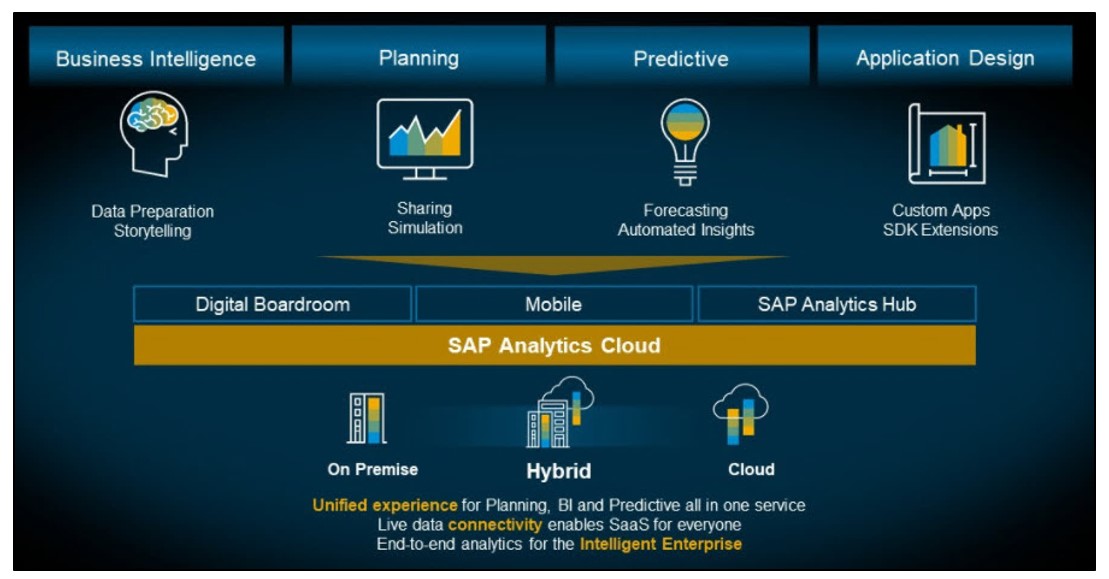
Figure 1. SAP® Analytics Cloud[4]
Copyright © 2021 SAP SE or an SAP affiliate company. All rights reserved.
In summary, the SAP® Analytics Cloud is a comprehensive and versatile analytics platform that offers companies a simple and flexible way to analyse data and make informed business decisions. It offers a variety of functions that enable users to integrate data from different sources to gain a comprehensive view of their business data. The ability to efficiently manage, analyse and interpret these data can have a significant impact on market direction and improve business performance. The platform offers a simple user interface and intuitive data analysis, enabling users to analyse their data without extensive IT knowledge. In addition, the platform also offers high scalability and availability to meet the growing data requirements of companies. The SAP® Analytics Cloud serves as a key component for precisely analysing data streams and creating meaningful reports. The focus here is on extracting insights from historical and current data to enable data-based decisions. The seamless integration of SAC into SAP® S/4HANA takes this analytical approach to a new level. The real-time processing capabilities of S/4HANA enable a direct connection to operational processes, allowing analyses to be carried out not only retrospectively, but also in real time.
S/4Hana Utilities
The S/4 Hana version developed specifically for the energy and water supply industry is called SAP® S/4HANA Utilities. It is based on the S/4HANA platform and offers comprehensive support for business processes in this industry, such as billing, invoicing, customer management, network management and energy data management. The solution utilises the technology of S/4HANA and SAP® IS-U (Industry-Specific Solution for Utilities) to automate processes and provide data in real time. This enables companies to organise their business processes more efficiently by improving data integration and process automation. The business processes already introduced in SAP® IS-U have been adopted and in some cases extended, enabling continued compliance with legal requirements and regulations. Some of the specific functions include the billing of grid utilisation fees, the invoicing of energy and water charges, the management of customer contracts and the management of grid data. In addition, options for monitoring and analysing energy data are also offered in order to improve the efficiency and sustainability of energy and water resources. Real-time data processing is also made possible, allowing decisions to be made more quickly and processes such as billing and invoicing to be carried out faster. This enables companies to optimise their business processes and expand their services for customers.
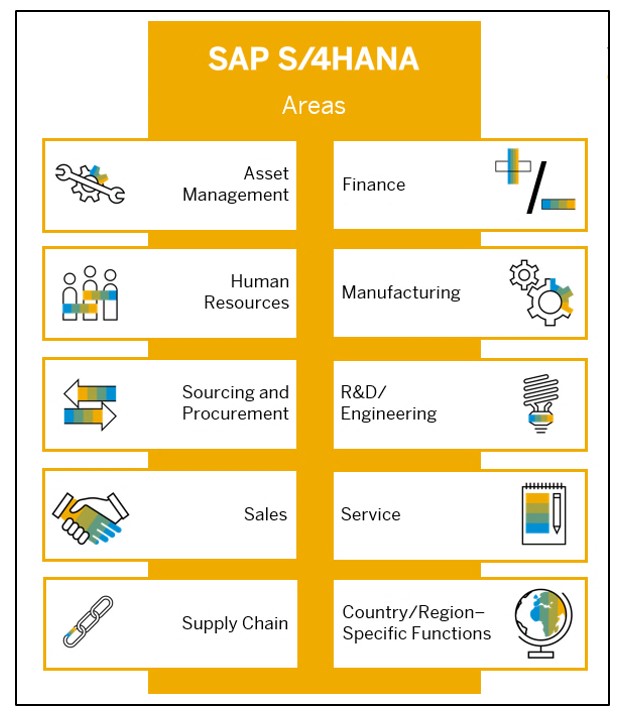
Figure 2. Areas in S/4HANA[5]
Copyright © 2021 SAP SE or an SAP affiliate company. All rights reserved.
While the cloud services of the Business Technology Platform are pure cloud applications that can only be run on the company’s own systems by using a “private cloud”, S/4Hana is an “on premise” product that is now offered as S/4 Hana Cloud, but was developed as the successor to the successful SAP® R/3® as an on-premise system that can be connected to various SAP® cloud products via ODATA services.
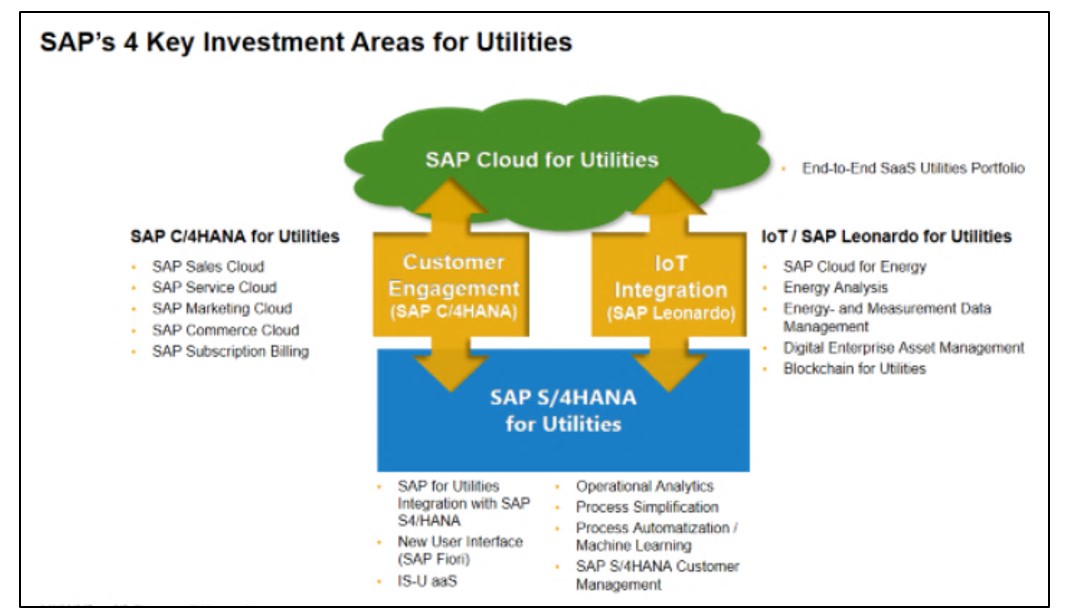
Figure 3. SAP’s 4 Key Investment Areas for Utilities[6]
Copyright © 2019 SAP SE or an SAP affiliate company. All rights reserved.
SAP® S/4HANA Utilities also offers the option of predictive maintenance. This enables companies to predict possible system and machine failures, thereby reducing downtimes and costs. Artificial intelligence and machine learning technologies are used to increase forecasting accuracy. Data from various sources such as sensors, network data and customer feedback are collected and analysed for this purpose. This provides an integrated view of the data and enables companies to make better decisions and optimise their business processes.[7]
This solution has been developed specifically for the requirements of the energy and water supply industry and therefore offers comprehensive support for business processes. This enables companies to automate their processes, process data in real time and make decisions based on accurate and up-to-date data. The data model under S4/Hana has remained largely identical to that of the SAP® R/3® IS-U module, which considerably simplifies data migration. This also meant that existing business processes, which are fundamental to the utilities industry, could be retained and expanded. The Application Process Engine (APE), which is used in S4/Hana Utilities, is very similar to the Common Layer Process Engine (PE). This means that existing expertise in the specialist departments of companies and consulting firms can continue to be used. These features and the similar “look and feel” of the IS-U successor to SAP® are reasons for the high level of acceptance of this product on the market. The simplified connection of cloud services and the powerful Hana database as a foundation, which can process the ever-increasing volumes of data with high performance thanks to its fast access times, form the basis for comprehensive usability in the future.[8]
SAP Fiori®
In order to make these new services usable for the end user in the company, an appealing and equally functional user interface is required. This interface between people and the ERP system is realised by SAP Fiori®. This is a collection of role-based applications for various business processes such as purchasing, financial accounting, human resources and more. These applications have been developed to provide a modern, appealing and user-friendly interface that can be used on various devices such as desktops, tablets and smartphones.[9]
The most important features here are role-based applications that are customised to specific business roles and tasks, allowing users to see and use only the functions that are required for their tasks. In addition, personalisation plays a major role, allowing users to adapt the applications to their specific requirements, for example by configuring the display of information and navigation. Mobile usability is another major advance. All applications are optimised for use on mobile devices and can be used via a mobile app or the mobile browser. State-of-the-art technologies are used to realise this. SAP Fiori® uses modern web technologies such as HTML5 and CSS3, which enable the applications to be displayed uniformly on different platforms and devices.
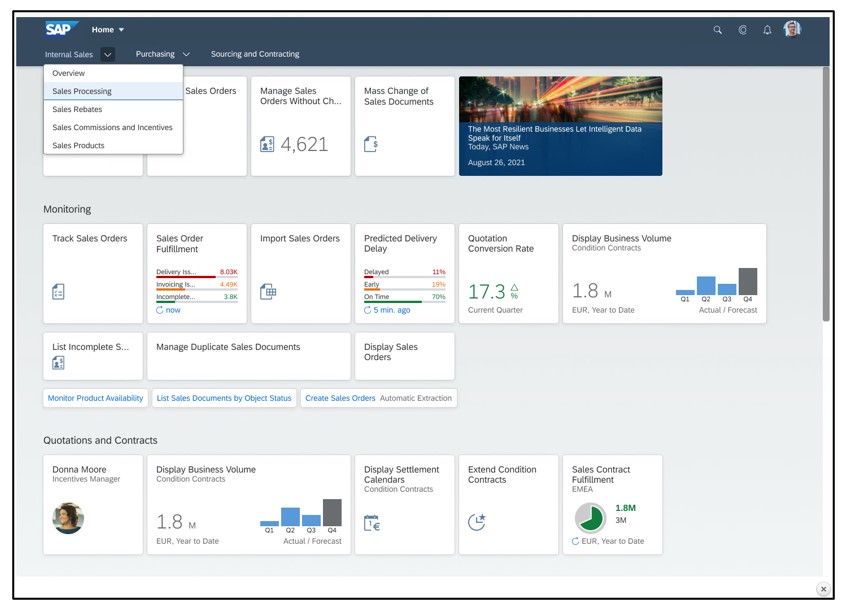
Figure 4. SAP Fiori® Launchpad[10] –
Copyright © 2021 SAP SE or an SAP affiliate company. All rights reserved.
The SAP Fiori® product also provides a high level of security by handling user authentication and authorisation via SAP® systems such as SAP® Single Sign-On (SSO) and SAP® Identity Management (IdM). It is also able to integrate with other SAP® systems such as SAP® S/4HANA and SAP® ERP to optimise business processes and share data, making it a great solution for companies looking to optimise their business processes and improve the usability of their applications. It enables organisations to make their business processes more efficient and user-friendly, which can lead to higher productivity and user satisfaction. In contrast, the S/4HANA for Customer Management product is designed to help companies improve their relationships with customers and optimise their business processes. It provides comprehensive support for customer management business processes, such as marketing, sales, service and customer care. The solution utilises SAP® CRM (Customer Relationship Management) and SAP® C/4HANA (Customer Experience) technology and offers companies the opportunity to better understand their customers and better meet their needs. It also enables companies to personalise their marketing strategies and optimise their sales processes in order to generate more revenue.[11]
Some of the specific functions of SAP® Customer Engagement include the personalisation of marketing campaigns, the optimisation of sales processes, the management of customer data and the management of service requests. It also offers tools for analysing customer data in order to increase customer loyalty. It also offers the option of collecting and analysing data from various sources such as social media, E-Mail and mobile applications, as well as providing an integrated view of the data. This enables companies to make better decisions and optimise their business processes. It provides comprehensive support for business processes in the area of customer management and enables companies to personalise their marketing strategies, optimise their sales processes and improve their services.[12]
The SAP® Sustainability Control Tower is an innovative solution from SAP® that aims to support companies in realising their sustainability goals, particularly with regard to improving corporate sustainability. This software offers a comprehensive platform that enables companies to efficiently collect, analyse and manage their sustainability data.

Figure 5. Holistic View on Sustainability Performance – Example WEF SCM Framework[13] –
Copyright © 2022 SAP SE or an SAP affiliate company. All rights reserved.
SAP® Sustainability Control Tower
The main features and functions of the SAP® Sustainability Tower include data integration and management. The SAP® Sustainability Tower provides a central platform on which companies can collect and manage all relevant sustainability data. These data can come from various internal and external sources and includes information on energy consumption, greenhouse gas emissions, water utilisation, waste management and much more. Another core feature is the powerful analysis and reporting capability. This allows companies to analyse complex data to gain insights into their sustainability performance. The software also allows customised reports and dashboards to be created, making it easier for decision makers to make informed decisions and monitor progress.
There is also compliance management, which supports companies in complying with various national and international sustainability regulations. The software can help to understand compliance requirements, collect data for regulatory reports and ensure that all relevant standards and guidelines are adhered to. To ensure that the targets set in this way are met, the software offers target setting and performance monitoring. This allows organisations to set specific sustainability targets and monitor progress using the software. This enables organisations to make strategic decisions in order to achieve their sustainability goals more effectively. The SAP® Sustainability Tower is integrated into the wider SAP® ecosystem, which means that it works seamlessly with other SAP® products and solutions. This facilitates the integration of sustainability aspects into various business processes and systems. In addition, the platform is user-friendly and can be customised to a company’s specific needs and requirements. This enables flexible customisation for different industries and company sizes.
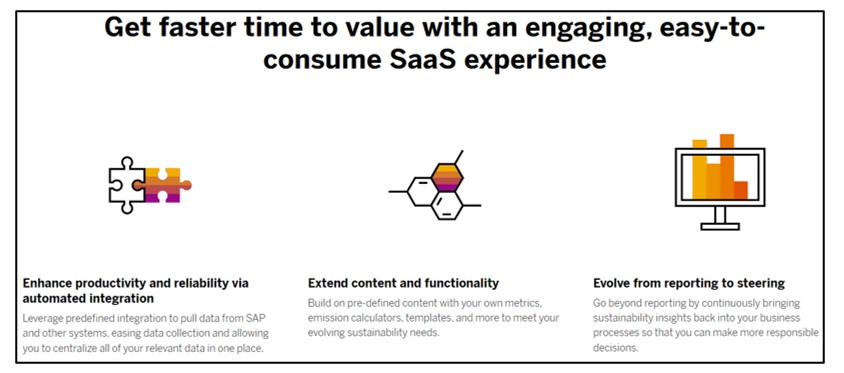
Figure 6. SAP® Sustainability Control Tower[14]
Copyright © 2021 SAP SE or an SAP affiliate company. All rights reserved.
By centralising sustainability data, companies can better understand the impact of their business activities on the environment and society and take targeted measures to improve their performance. The platform also offers a comprehensive reporting system that supports companies in creating sustainability reports and communicating their sustainability performance to customers, investors and other stakeholders.[15]
ESG reporting (Environmental Social Governance) is an initially voluntary but gradually mandatory disclosure of corporate key figures on sustainability and social responsibility. The EU Commission’s new Corporate Sustainability Reporting Directive (CSRD) will make ESG reporting mandatory from the 2025 financial year for all companies that fulfil at least two of the following three criteria. The company must have more than 250 employees on an annual average, the company must generate more than 40 million euros in turnover and/or the company must have more than 20 million euros in total assets. In addition, small and medium-sized companies that are listed on the stock exchange will also be affected from 2026.[16] From this point onwards, companies are obliged to prove that they have purchased a product from their supply chain from the most environmentally friendly supplier. This includes, for example, the supplier’s production conditions and the distance between the supplier and the company in order to minimise shipping distances. As this data collection will only be possible using an integrated system, companies will in future be forced to introduce supporting software in order to fulfil their reporting obligations, analogous to the legal requirements with regard to the prescribed market processes. This product can also be seamlessly integrated into existing business processes in order to obtain a comprehensive view of business and sustainability performance. Integration with other SAP® solutions such as SAP® S/4HANA and SAP® Ariba is also possible to ensure seamless integration of sustainability data into business processes.[17]
Conclusion
The SAP® products shown here play a central role in promoting a sustainable future in the utilities industry. SAP Fiori® improves the user experience with an intuitive interface that increases efficiency and facilitates access to key information. The SAP® Sustainable Control Tower provides a comprehensive view of sustainability aspects and supports the monitoring and adjustment of sustainability targets. The SAP® Technology Platform serves as a robust basis for the digitalisation and integration of business processes, while the SAP® Analytics Cloud provides advanced analytical functions for data-driven decisions. S/4Hana Utilities is specifically tailored to the utilities industry and promotes process optimisation and energy efficiency. Finally, S/4Hana for Customer Management improves the customer experience and supports efficient customer interactions. Overall, these solutions offer an integrated system that supports the utilities industry in its digital transformation and makes a significant contribution to achieving sustainability goals.
[1] Cf. (2023) https://community.sap.com/topics/business-technology-platform
[2] Cf. (2023) https://www.sap.com/germany/products/technology-platform/cloud-analytics.html
[3] Cf. (2023) https://www.sap.com/germany/products/technology-platform/cloud-analytics.html
[4] Cf. (2021) https://blogs.sap.com/2021/09/30/sap-analytics-cloud-technical-guide/
[5] Cf. (2023) https://help.sap.com/docs/SAP_S4HANA_ON-PREMISE
[6] Cf.(2019) https://blogs.sap.com/2019/10/03/sap-s4hana-utilities-where-we-are-at-how-to-get-to-s4hana-summary/
[7] Cf. (2023) https://help.sap.com/docs/SAP_for_Utilities
[8] Cf. (2021) https://www.heise.de/news/SAP-konzentriert-sich-auf-hauseigene-Datenbank-1376910.html
[9] Cf. (2023) https://www.sap.com/products/technology-platform/fiori.html
[10] Cf. (2022) https://experience.sap.com/fiori-design-web/launchpad/
[11] Cf. (2019) https://help.sap.com/doc/dc7d5ac9812d4b16bba92b32f0780691/1809.001/en-US/loioa0b04afeaa034a19b604a5530cad0984.pdf
[12] Cf. (2023) https://help.sap.com/docs/SAP_S4HANA_FOR_CUSTOMER_MANAGEMENT
[13] Cf.(2021) https://blogs.sap.com/2021/12/14/getting-esg-reporting-and-performance-management-under-control-with-the-sap-sustainability-control-tower
[14] (2023) https://www.sap.com/products/sustainability-control-tower.html
[15] Cf. (2023) https://www.sap.com/products/sustainability-control-tower.html
[16] Cf. (2022) https://www.luenendonk.de/aktuelles/themen-trends/jetzt-die-weichen-stellen-esg-reporting-nimmt-nun-auch-den-mittelstand-in-die-pflicht/
[17] Cf. (2023) https://www.sap.com/products/sustainability-control-tower.html
References
- HEISE MEDIEN GMBH & CO. KG, (2021), SAP focuses on in-house database. [online], [Retrieved 15.12.2023], https://www.heise.de/news/SAP-konzentriert-sich-auf-hauseigene-Datenbank-1376910.html
- LÜNENDONK & HOSSENFELDER GMBH, (2022), Setting the course now: ESG reporting now also takes SMEs to task. [online], [Retrieved 15.02.2024], https://www.luenendonk.de/aktuelles/themen-trends/jetzt-die-weichen-stellen-esg-reporting-nimmt-nun-auch-den-mittelstand-in-die-pflicht/
- POWLAS, T.P., (2019), SAP S/4HANA Utilities – where we are at, how to get to S/4HANA Summary. [Online], [Retrieved 12 Mar. 2023], https://blogs.sap.com/2019/10/03/sap-s4hana-utilities-where-we-are-at-how-to-get-to-s4hana-summary/
- ROTHERMEL, G.R., (2021), Getting ESG Reporting and Performance Management Under Control with the SAP Sustainability Control Tower. [Online], [Retrieved 13.01.2024], https://blogs.sap.com/2021/12/14/getting-esg-reporting-and-performance-management-under-control-with-the-sap-sustainability-control-tower
- SAP COMMUNITY, (2021), SAP Analytics Cloud: Technical Guide. [online], [Retrieved 05.03.2023], Available from: https://blogs.sap.com/2021/09/30/sap-analytics-cloud-technical-guide/
- SAP COMMUNITY, (2019), SAP Business Technology Platform. [Online], No information on publishing date, [Retrieved 05.01.2024]. https://community.sap.com/topics/business-technology-platform
- SAP GERMANY SE & CO. KG, SAP Analytics Cloud. [Online], No information on publishing date, [Retrieved 15.01.2024], https://www.sap.com/germany/products/technology-platform/cloud-analytics.html
- SAP GLOBAL, SAP Fiori – The enterprise user experience, reimagined. [Online], No information on publishing date, [Retrieved 08.12.2023], https://www.sap.com/products/technology-platform/fiori.html
- SAP GLOBAL, SAP Sustainability Control Tower. [Online], No information on publishing date, [Retrieved 05.12.2023], https://www.sap.com/products/sustainability-control-tower.html
- SAP HELP PORTAL, SAP for UTILITIES Product Assistance. [Online], No information on publishing date, [Retrieved 12.01.2024], https://help.sap.com/docs/SAP_for_Utilities
- SAP HELP PORTAL, (2019), What’s New in SAP S/4HANA for Customer Management 2.0 FPS01. [Online], [Retrieved 05.01.2024], https://help.sap.com/doc/dc7d5ac9812d4b16bba92b32f0780691/1809.001/en-US/loioa0b04afeaa034a19b604a5530cad0984.pdf
- SAP HELP PORTAL, SAP S/4HANA for Customer Management. [Online], No information on publishing date, [Retrieved 08.01.2024], https://help.sap.com/docs/SAP_S4HANA_FOR_CUSTOMER_MANAGEMENT
- SAP HELP PORTAL, SAP S/4HANA Product Assistance. [Online], No information on publishing date, [Retrieved 12.03.2023], https://help.sap.com/docs/SAP_S4HANA_ON-PREMISE
- SAP USER EXPERIENCE COMMUNITY, Fiori for Web Design Guidelines. [Online], No information on publishing date, [Retrieved 12.01.2024], https://experience.sap.com/fiori-design-web/launchpad/








